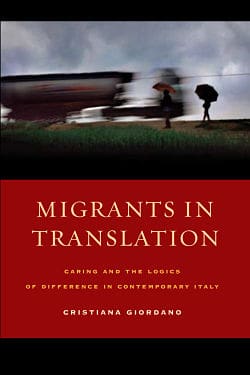Contemporary phenomena of migration and human trafficking pose challenges to modern states, which may struggle to deal effectively and fairly with how to address issues of integration and fulfil their humanitarian and therapeutic responsibilities. Migrants in Translation, taking its point of departure from a small ethno-psychiatric clinic (the Centro Franz Fanon) in Turin, examines how various Italian state and non-state agencies involved in the care of female asylum seekers, refugees and migrants respond to these demands. The ethnographic trail leads through NGO offices, the police department and the shelters run by Catholic nuns, as Giordano tracks the legal and biopolitical processes within which the women – many of whom are classed as victims of human trafficking – are caught up. However, it is the Centro Franz Fanon, a specialist ethno-psychiatric consultation service that advises and takes referrals from the other agencies on matters of ‘culture,’ that remains the connecting narrative thread running through the book. Its distinctive approach and close engagement with anthropological debates provide Giordano with a counterpoint against which to compare the work done in the other institutions. The result is a stimulating and insightful meditation on how the state’s politics of difference and recognition shape migrant experience, and on whether ethno-psychiatry might offer clues as to how to think through these notions differently.

This notion of digestibility applies as much to the diagnostic categories used by mental health services as it does to the bureaucratic state processes that determine migration status. While the need for awareness of cultural context in psychiatry is now widely recognised (APA 2013: 749), medical anthropology has repeatedly shown how in practice this can often unfold within the same restrictive frameworks as the state’s politics of recognition. To take just one example, Santiago-Irizarry (2001) describes how well-intentioned ‘culturally sensitive’ services for Latinos in the United States ended up projecting essentialised and static identities on to their clients, which only reinforced tendencies to match them against perceived Anglo-American norms. In Giordano’s analysis, however, something very different is happening through the Centro Franz Fanon’s engagement with culture. This is described in Chapters 1 and 6, which engage ethnographically with the ethno-psychiatric clinic, exploring how its practitioners approached their therapeutic work with Nigerian and East European migrant women, and how they tackled questions of culture in the process.
Chapter 2 adds depth to this portrait by exploring the intellectual influences that inspired the centre’s outlook: Fanon’s radical anti-colonialist writings; theorists of psychiatry and culture such as Tobie Nathan, Ernesto De Martino and Octave Mannoni; the political thought of Gramsci; and Franco Basaglia’s democratic psychiatry movement of 1970s Italy. The ideas and politics of these thinkers, alongside anthropological training that in some cases has involved extended fieldwork, inform how centre practitioners juggle different notions of culture in their clinical work. Both the author and the therapists identify the tensions between clinical and anthropological understandings of culture. The ethno-psychiatrists’ solution is to use culture “as if [it] is a tool” (p. 49), something that can be used to develop an interpretation or build a therapeutic relationship. However, this may be only one stage in the therapeutic process. Their ultimate aim is for the most part to destabilise hegemonic explanations of their clients’ situations (be they psychiatric or cultural) and help them to explore different perspectives and possibilities.
The book highlights the distinctiveness of this goal and of the ethno-psychiatric consultation service itself by exploring the migrant women’s experiences of the other agencies with which they come into contact.
Chapter 3 discusses ethno-psychiatrists’ work with other services and practitioners to whom they provide ‘cultural’ input and supervision. Here the practical limitations of ethno-psychiatry become manifest, as we see how difficult the clinicians find it to destabilise established dichotomies between ‘pathological behaviour or cultural norm’ and ‘victim or agent’. The force of these discourses comes from how they provide a basis for the state to include migrants on its own terms, rather than in ways that might take seriously their real concerns.
Chapter 4 develops the theme of migrants’ agency through an examination of the denuncia, the formal filing of charges against the traffickers who exploited the migrant women. That many of Giordano’s informants sometimes challenge the identity of ‘victim’ that this process crafts for them, find the question of exploitation far from clear-cut, and regard the denuncia as an imperfect representation of their experiences, seems largely irrelevant to the legal process involved. It is only through the production of denuncia narratives that follow the expected conventions that these women can be ‘digested’ by the state; confession along certain, expected lines is often the only way to regularise their residential status. Thus, the cultural mediators who assist them with the process find themselves restructuring the women’s accounts as they seek an uneasy balance between the messiness of real-life experience and the confines of what law enforcement agencies expect to hear.

Photo by European Commission DG ECHO (flickr, CC BY-NC-ND 2.0)
Chapter 5 considers life in the shelters run by Catholic nuns for women who have been trafficked. The script laid out for residents is one of progress from the state of dependency that they have been left in by their experiences of exploitation, towards an idealised independence and maturity. Paradoxically, some of the women take the view that the forms of independence they are encouraged to strive towards actually leave them with less agency than they had when they were supposedly being victimised. The chapter argues that the state and the church are closely compatible in the ways that they deal with migrant women, having recourse to similar confessional logics and employing similar teleologies of redemption.
This account of other agencies underlines the different position occupied by the Centro Franz Fanon. A space that seeks to avoid teleologies in favour of listening, it attempts to remain open to multiple forms of ‘difference’ without foreclosing meaning or prioritising cure at the expense of care. It embraces neither psychiatry nor culture as monolithic explanations for behaviour. Giordano argues that this ethno-psychiatric institution opens possibilities for the radical disruption of fixed categories and discourses through which other institutions position the migrant. Rather than ‘recognition’, she suggests that the work of the centre is better encapsulated in the term ‘acknowledgement’, an outlook that connotes an awareness and openness to the other’s experience rather than a need to assimilate it by translating it to known categories.
One area that seems under-examined is the views of the women themselves on the ethno-psychiatric encounter. The ethnography of the ethno-psychiatry clinic conveys little about how the clients responded; though rich, it focuses largely on the therapists’ perspectives.
We read the latter’s theoretical and clinical justifications for certain interventions, but are told little about how useful users of the service find the therapy sessions. To what extent did they value the therapists’ stance in relation to culture and interpretation, and to what extent did they view the centre as just another institution to navigate? Giordano may have felt that the limits of her data made it difficult for her to make informed judgements on these questions, but the lack of reporting on the women’s views on ethno-psychiatry stands in contrast to the ample discussion of their views on the other institutions considered. This is unfortunate, as it leaves her analysis of ethno-psychiatry’s potential resting largely on theoretical grounds, rather than on empirical demonstration.
Despite this gap, Migrants in Translation makes an important scholarly contribution in highlighting the rigidity of the discourses that shape the social rehabilitation and integration of trafficked women. More broadly, it productively explores how the various practitioners involved with them employ the concept of culture in the course of their work, and how this might be done differently. These achievements make the book a rich ethnography with much to say to scholars of migration, mental health, and the uses and abuses of culture.
References:
American Psychiatric Association. 2013. Diagnostic and Statistical Manual of Mental Disorders, 5th Edn. Arlington, VA: American Psychiatric Association.
Santiago-Irizarry, Vilma. 2001. Medicalizing Ethnicity: The Construction of Latino Identity in a Psychiatric Setting. Ithaca: Cornell University Press.
**************
Featured photo by Photo Unit (flickr, CC BY-NC 2.0)









